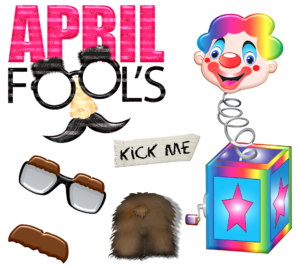
Happy April Fools’ Day. Are you more prankster or prankee? What’s the best prank you ever pulled…or that got pulled on you?

by James Scott Bell
@jamesscottbell
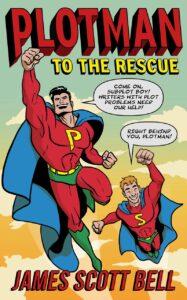 (Today’s post is adapted from the book Plotman to the Rescue: A Troubleshooting Guide to Fixing Your Toughest Plot Problems. It is used by the kind permission of the author.)
(Today’s post is adapted from the book Plotman to the Rescue: A Troubleshooting Guide to Fixing Your Toughest Plot Problems. It is used by the kind permission of the author.)
Here’s a question I get from time to time. What do I do if I’m in the middle of my novel and there are so many things happening, so many characters running around, that I’m losing my way?
You would think this question would come primarily from “pantsers,” the If-I-knew-what-my-story-was-about-before-I-wrote-it-I’d-be-bored school of writing. But it arises with the plotter, too, who has perhaps been overly ambitious in the planning. As sometimes happens for the plot engineers, a sudden twist or turn or character may try to horn in at, say, the 20k mark, throwing the whole outline off.
So what do you do when you discover you’ve a) gone down that infamous rabbit hole; b) have plot points or characters popping up you didn’t plan for; c) are lost in a dark forest; or d) have fallen off a cliff into the bleached bones of the author’s graveyard?
I will allow you one wail of frustration.
Now let’s get a handle on things.
First of all, where are you, as the ad men used to say, “outline wise”? Do not skip over this part, pantsers, for you better have an outline, too.
Wait, what?
I’m talking about a “rolling outline,” one you put together as you roll along. When you finish a scene or chapter, write a quick synopsis of who the viewpoint character is, what he wants and what happens, as in: Ishmael gets depressed, decides to go to sea, and sets off to find a ship.
Scrivener is ideal for this because you can put the rolling outline on scene “cards” and view them on a virtual corkboard. But Word or even Excel will work fine, too.
Now, if you feel your plot is getting away from you, print out the current version of the rolling outline and do this:
Clean House on Characters
How many viewpoint characters have you got? This means you have more than one character with a storyline of their own. For example, in a traditional romance you usually have two viewpoint characters, the lovers. In a long historical or fantasy novel, you may have three, four or more.
If this is so for you, precisely define the following: What is each character’s death-stakes objective? (Death being physical, professional, or psychological.) If it’s not death, find a way to make it so, or drop this as a plotline. In the alternative, consider taking away this character’s viewpoint scenes and converting that line into a subplot. This means the character shows up in scenes told from another character’s point of view and (this is crucial) complicates the viewpoint character’s objective.
For example, you have a woman as a viewpoint character, and a man as another viewpoint character. The man’s plotline is not working out in a death-stakes way. You might remove him as a viewpoint, but have him show up in the woman’s plotline as a potential lover or long-lost brother or secret agent or alien from a parallel universe.
Clean house. Keep only the crucial characters.
For further study: The Stand by Stephen King, and Strangers by Dean Koontz. You’ll see how these authors make the several character lines work on their own terms before bringing the strands together.
Cut Scenes That Don’t Connect to Plot
Now that you are squared away on the objective of the main character or characters, assess each scene you’ve written so far. Ask:
Write or Rewrite Your Pitch
If you’re a pantser, you may not have a pitch for your novel. After all, you’re still discovering what it’s about! Well, if you’ve done some thinking as this post suggests, you’ve made discoveries. Try putting them together in a pitch—250 words or less that would make someone interested in this story. Doing this will give you focus on where to go next.
If you’re an outliner, rewrite your pitch to include the elements you’ve uncovered. Get excited again about your journey.
Be sure to read Sue’s post on crafting a pitch.
Push On
Now finish your draft. Don’t do any more dawdling. You should have enough direction to push right on to the end. As you do, keep adding to your rolling outline. It will be helpful when you get to the editing stage.
Can you describe a time when your plot got away from you, or you felt lost? Is this a common occurrence for you? What do you do to get back on track?
by James Scott Bell
@jamesscottbell
 Here’s a fun little exercise I’ve used from time to time to jumpstart the ol’ creative battery. It only takes about 90 seconds.
Here’s a fun little exercise I’ve used from time to time to jumpstart the ol’ creative battery. It only takes about 90 seconds.
Begin by finding a quiet spot where you will not be interrupted. Sit in a comfortable chair, feet on the floor. Relax. Close your eyes and take a few slow, deep breaths.
Now imagine that you are walking through a beautiful meadow. Take time to smell the flowers. (Note: there are no cows in this meadow.)
Up ahead you see a cabin with a bit of smoke curling out of the chimney. Vividly imagine this cabin. Notice the materials and the colors. Smell the smoke.
You walk up to the door and find it slightly open. You step into the cabin and see a famous writer—or one of your personal favorites—tapping away at a keyboard. (Note: The writer can be deceased, but try not to pre-choose who it is. Let your right brain hop in and provide the answer.)
The writer looks at you, slightly annoyed at being interrupted, and you tell said writer that you have come for one piece of writing advice that you desperately need. The writer, who is somehow familiar with your work, thinks for a moment, and says, “_______.”
Here’s what happened when I did this a few days ago. The writer was John D. MacDonald. He was writing on an electric typewriter with his ever-present pipe in his mouth.
He finished typing a sentence and looked at me.
I said, “Sorry to interrupt, but I really need a piece of advice for my writing. Would you mind?”
MacDonald took a couple of thoughtful puffs, then said, “Work harder on your sentences.”
I wanted to pull up a chair and ask him to elaborate. But he waved me off. “I have to get back to work,” he said and started typing again.
I walked back through the meadow, pondering his advice. I remembered something he once said about his own style. He wanted it to have “a bit of unobtrusive poetry.”
The key word is unobtrusive. He didn’t want readers noticing the poetry, just feeling it as it served the story.
I had to admit I wasn’t taking enough time lately to think about my sentences. I determined to do more light editing after I’ve written a scene to see if I can add just a touch of unobtrusive poetry. I started to think about how. I can:
You can do this exercise whenever you need some inspiration. In the past I’ve received advice from Hemingway, Mark Twain, and Raymond Chandler.
Then I let them get back to work.
Care to try it? Don’t make something up on the spot. You want your subconscious to participate. Follow the steps for at least a minute and a half.
Who did you find in the cabin, and what did that writer tell you? What will you do with the advice?
by James Scott Bell
@jamesscottbell
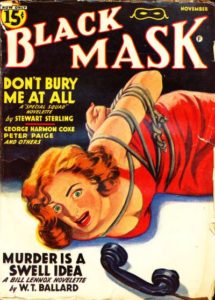 People want stories. I would argue people need stories. That’s how the great pulp writers made their living—providing fast-moving tales for readers who longed for escapism, especially during the Great Depression.
People want stories. I would argue people need stories. That’s how the great pulp writers made their living—providing fast-moving tales for readers who longed for escapism, especially during the Great Depression.
Pulp fiction, like jazz, is an American phenomenon. Pulp refers to the cheaper paper (wood pulp) that these magazines used to save money. The mags came out every month, stuffed with new stories for a voracious reading public. The golden age was between the World Wars. Dozens of magazines offered crime, detective, fantasy, action, sports, and Western fiction, with eye-catching and often lurid covers to tantalize the harried businessman as he walked by the newsstand.
To make a living in the pulps, which paid on average a penny a word, you had to be prolific. That meant several stories flying through the postal system, and when one came back rejected, slapped in another envelope and sent off to another editor.
The best of the pulpsters quickly figured out that a great series character was, in the words of Erle Stanley Gardner, the “pulp writer’s insurance policy.” When a character caught on, subsequent issues of the magazine could advertise “a new Doc Savage story” thus guaranteeing sales.
After trying out several series characters in Black Mask, Gardner hit on Perry Mason, who became not just his insurance policy but his lifetime annuity as well.
As you may know, I run my own personal pulp fiction “magazine.” It was here I developed a series character in classic pulp style—a troubleshooter for a Hollywood studio in 1940s Hollywood named William “Wild Bill” Armbrewster.
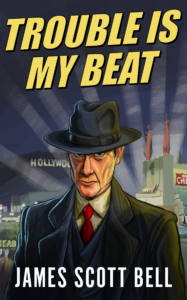 Armbrewster solves problems for National-Consolidated Pictures. That means getting leading men out of the drunk tank … or a murder rap. It means keeping wolves away from starlets and dancers away from temptation. Once it even means helping Bette Davis out of a jam.
Armbrewster solves problems for National-Consolidated Pictures. That means getting leading men out of the drunk tank … or a murder rap. It means keeping wolves away from starlets and dancers away from temptation. Once it even means helping Bette Davis out of a jam.
His beat is trouble and his fists are ready.
He’s got some Sam Spade and Philip Marlowe in him, and a bit of Bill Lennox, the character created by W. T. Ballard for Black Mask. My collection of six Bill Armbrewster novelettes is up for pre-sale at the deal price of $2.99 (it goes up to $4.99 after launch week). You can snag your copy here. Outside the U.S., go to your Amazon store and search for: B09V1RLXDM
There will be a print version, too.
As an added feature, I’ve put together an extensive glossary of 1940s pulp slang. This will be a good education for the kids who want to read and understand classic crime fiction, and enjoy film noir to the full.
So how about a quiz? Here are a few terms from the glossary. How many can you translate? (Keep score, then see my answers in the comments section. No peeking!)
Adam and Eve on a Raft
Ameche
Bunk, The
Chicago overcoat
Clip joint
Educated puppies
Palooka
Pan
Roscoe
Sawbuck
T’aint funny, McGee
Thanks for letting me toot my own horn today. Enjoy the book. After all, entertainment is my beat.
by James Scott Bell
@jamesscottbell
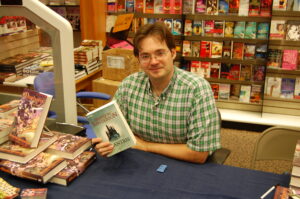
Brandon Sanderson
Have you heard about what Brandon Freaking Sanderson is doing? As they used to say in the 60s, “It’ll blow your mind, man.”
Last Tuesday Sanderson made a “surprise announcement” via YouTube, telling his fans that over the course of the last two years he has produced four—count ’em, four—“secret” novels. Instead of releasing these books through a traditional publisher, Sanderson is running a Kickstarter campaign to sell directly to his readers. The books will be delivered each quarter in 2023. And not just books. At certain levels supporters receive a box of Sanderson swag in each of the other eight months.
When you run a Kickstarter, you choose a minimum goal for your campaign. If you don’t hit it, the pledges aren’t collected. Sanderson set his goal at $1 million.
In one day his pledges hit $15 million.
In three days he raised over $20 million (from 84,600 backers) and officially became the most successful Kickstarter in history. And the campaign is open until the end of the month!
It doesn’t stop there. After the books are delivered, Sanderson will turn around and license those rights to a traditional publishing company and reap those royalties, too.
This is, in short, an awesome display of how to exploit intellectual property.
However, some things to keep in mind at this stage of my post.
If that is so, why am I bothering to write about this? First of all, it’s publishing news. It’s viral. And it’s amazing. Just thought you’d like to hear about it if you haven’t already.
Second, to get to the basic reasons why Brandon Sanderson is able to do this, note that he is: a) a very good writer; b) prolific; and c) nurturing of his fans.
Thus, while very few writers ever get to the Sanderson level, we can do the same three things within our own sphere. To wit:
Be Good
You know me. I believe in a never-ending self-improvement program for writers. We expect that from doctors and plumbers; why should we not expect it from artists who ask us to spend money on them?
Write, study, write, get feedback, improve. Write. That’s how you get to be good.
Be Prolific
Brandon Sanderson is a writing monster. I mean, not only has he written his own epics, he hired on to complete another massive series after the original author died! (The Wheel of Time books).
Not many of us have the time to produce on that scale. But we can all produce with the time we have. I’ve said it often here and in my workshops, and I still consider it the best piece of advice I got as a new writer—write to a quota. I put it this way: figure out how many words a week you can comfortably produce. That means what you can write without turning the rest of your world—family, friends, day job—into a maelstrom of stress, anxiety, recrimination, illness or the desire to overeat.
Be easy on yourself. Find your comfort zone, then up that total by 10% as a stretch goal. Make this a weekly quota divided into six days. That way, if you miss a day, you can make it up by writing a little more on the other days. Take one day off to recharge.
If you miss your weekly number, forget about it. Start your new writing week fresh.
Be Nurturing
As your readership grows, find ways to connect with your audience. You can do this by:
Could I do more? Yes, but I’ve calculated the cost/benefit for me is ultimately negative. I want to spend most of my creative capital writing more books.
As a final thought, I’m sure many writers look at the Sanderson numbers—and the numbers of many others in a higher income level—and feel some variation of envy over the money being made. Don’t let that happen. Every writer wants to make good dough and therefore has to utilize business thinking to one degree or another. But that degree depends on your personality and what kind of life you want to live.
For example, the quest for success can wreak havoc on personal relationships (you could have asked any one of Norman Mailer’s six wives about that). Money is a powerful motivator but can also be a menacing siren. As a wise Nazarene carpenter once observed, “Be on your guard against all kinds of greed—life does not consist in an abundance of possessions.”
On the other hand, a writer who creates without even a sideward glance at the market should not later howl at the moon because his stuff doesn’t sell.
Balance is the key. It’s different for each of us. I feel, after over 25 years in this game, that I’ve found my sweet spot. That doesn’t mean I don’t continue to learn and explore ways to increase my revenue. But I don’t run after every money-making morsel like a hungry ferret. Thus, don’t look for me on Kickstarter or doing dance videos on TikTok (my daughter is greatly relieved).
And whenever doubts or disappointments start to creep in—Am I doing enough? Am I fooling myself? Will I ever be as successful as ____? Or even ____?—determine to write just one more sentence…and write it! Then write the one after that. Get lost again in the joy of making stuff up. That is your safe haven, your home sweet home.
In short: Carpe Typem. Seize the Keyboard!
The questions for the day are as follows: Do you have an idea of what kind of balance you want from your writing life? Do you feel stress about any aspect of it? How would you describe your ideal writing profile?
by James Scott Bell
@jamesscottbell
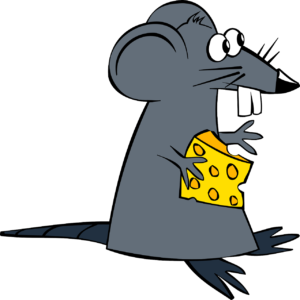 I hope you’re not munching a donut or toast right at the moment.
I hope you’re not munching a donut or toast right at the moment.
You probably saw the story about the closing of 400 Family Dollar Stores due to a rat infestation at one of their distribution centers. After a whistleblower’s report, the FDA went in and found a thousand “dead rats and birds” scattered inside.
Warehouse worker Robert Bradford says he was fired from West Memphis distribution center, Arkansas, after he shared footage last month of rats fighting together on the warehouse floor, scurrying up and down the aisles, and a dead rat that had been caught in a trap.
Kind of makes you want to run right out to a 99¢ store and buy a can of Vienna sausages, doesn’t it? The report also included this little item:
Bradford’s clip also showed an unidentified coworker trying to feed one of the rats a Pringle with his own bare hands.
Hey, the little fellas have to eat, right? And what else should you do with a Pringle anyway?
Family Dollar has since initiated a voluntary recall on certain products from the distribution center, with the comforting words, “We take situations like this very seriously and are committed to providing safe and quality products to our customers.”
Nice to know!
Never one to turn down an apt metaphor, I am now just as concerned about Rodents in the Warehouse operating right next door to the Boys in the Basement.
For review, The Boys in the Basement is Stephen King’s metaphor for the writer’s subconscious mind. Down below the conscious level the imagination always churns and gets ideas. Those ideas are stored in the warehouse part of our brains. There are things we can do to unlock the warehouse—like writing morning pages.
But what about rodents getting into that same warehouse? These are mental pests, and they’re real. If left alone, some of the best and most creative ideas and books will never make it to our mind, let alone the marketplace.
One big fat rat is fear. Fear that your ideas aren’t good enough. Or marketable enough. Or might offend someone. Or might make you seem like a drunken fool. Fear is always lurking around the writer’s mind, and needs to be dispatched forthwith.
One way to do that is by writing a half-page précis of your ideas. Not a synopsis, just your summary of why you think the idea might fly, who might like it, and—most important—why you are jazzed about it.
If you find, after doing this exercise, you’re not that excited after all, you can move on. At least it won’t be out of fear.
But do get a couple of people to give you feedback on it. Are they as interested as you are? If not, again, you can get along to the next idea.
Which leads us to another corpulent rodent—disorganization. If you leave your ideas lying around randomly, you’ll never give them the focused attention they deserve.
The answer is to clean up and organize your warehouse. Don’t leave any idea untended. When you find it, put it on a shelf. I suggest a master document just for ideas. I have one with opening lines, quick concepts (usually starting with What if?), possible characters, possible settings. I go over this from time to time and find the ones that still strike me and develop them further. These go into another file called “Front Burner Concepts.” That’s where I go when I’m ready to choose a new project to write.
Finally, a whole pack of rats like to strike when you experience burnout. If our brain gets tired from overwork, we don’t have anybody watching the warehouse. Lots of good stuff gets gobbled up.
I wrote about this in my book The Mental Game of Writing. Here’s a clip:
The thing to do about burnout is head it off at the pass. And the best way I know is to observe a Writing Sabbath. Just like when God knocked off for the week.
It can be on any day you choose. As I mention in the Discipline chapter, I choose Sunday.
On that day I do not do any writing or even thinking about writing (at least I try not to think about it. It’s the day when the Boys in the Basement get to work out in earnest).
It’s a good day to catch up on my reading.
And my relationship with my wife! We’ll take a trip to the beach, or go up in the hills and look at the view. We’ll watch a movie together, have a nice dinner….
If it’s football season, I’ll watch a game or two.
I try to get out in the sunshine.
What all this means is that the pressure is off.
Though sometimes my mind and my fingers want to write something. It’s sort of like the thoroughbred that is primed to run every day, but one day is just hanging out with a blanket and some hay. The legs tremble. The nose sniffs the air.
At times like that I keep my legs calm and my nose in a book.
What about during your writing week?
Two things if you can manage them: get exercise and get very quiet.
The benefits of even short bursts of exercise are well known. Walk around as much as you can, if that’s the least you can do.
Follow the Pomodoro Method. Write for twenty-five minutes, then take a five-minute break. Do some walking or deep breathing (with your eyes closed).
Also, I’m a big believer in the power nap. That’s a twenty-minute or so stretch of nodding off sometime during the work day. We all have a “zombie time.” For me it’s around 1 or 2 o’clock. My mind turns to jelly.
So I trained myself to get to sleep quickly and wake up twenty minutes later. You can do this, too. It will take you about two months to instill the habit, if you so desire.
In sum, your Boys keep at their work. Your job is to keep the Warehouse clean. Then what you bring to market will not have to be recalled.
Bon appétit!
Do you find any other pests sniffing around up there in your brain? Do you have methods to organize your madness?
by James Scott Bell
@jamesscottbell
 Terry’s recent post observed, “As writers, we don’t read the same way ‘normal’ people do. We have internal editors who insist on reading along with us and shouting their opinions.” That’s because we are attuned to the craft; we know the rules guidelines that should not be broken ignored lest we “pull” the reader out of the story.
Terry’s recent post observed, “As writers, we don’t read the same way ‘normal’ people do. We have internal editors who insist on reading along with us and shouting their opinions.” That’s because we are attuned to the craft; we know the rules guidelines that should not be broken ignored lest we “pull” the reader out of the story.
Often these are little things. I call them speed bumps. The more there are along the story road, the less the reader will enjoy the ride. Much of my teaching is devoted to speed bump removal. The downside is that it’s harder for me to read just for pleasure. I can’t help lingering over the bumps I encounter and imagining ways they could have been eliminated.
This happened recently when I went back to re-read a novel in a popular series. I was only a few pages in when I got majorly bugged by something:
1. An eating scene that defies the laws of physics (and has no conflict)
In the first chapter the series hero sits down to dine with a client. A waitress comes to the table, takes their order and leaves. The two principals chat a bit. The speedy waitress returns with drinks. More chatting (about 30 seconds worth in read-aloud time) and the world’s fastest waitress, apparently working with the world’s fastest chef, came with our filets.
Another chat session (1 minute, 23 seconds) during which one character takes one bite of filet. Then: The waitress came to clear our dishes. We ordered creme brulee for dessert.
There follows two lines of dialogue. Two! Five seconds in real-world time. Then: The waitress came with the creme brulee.
Gadzooks! This waitress must be the only human to break the land speed record at the Bonneville Salt Flats…without a car!
Forty-three seconds more of chatting, then: My creme brulee was gone.
Holy Coneheads! These character must eat like this:
I’m sure many a reader would notice the same thing. Maybe not enough to toss the book aside, but it is so unnecessary and so easily fixed! Just a few lines of narrative summary sprinkled throughout would have sufficed. Something like: We lingered over our filets, talking about her past, her ex-husband, and the train she missed in Paris. By the time we were ready to order dessert, I thought I knew her as well as my own sister.
Plus, all the dialogue was friendly and informational. No conflict or tension. Thus, boring. Again, it would have been so easy to add a little argument, a disagreement, a bad vibe. (See my further notes on eating scenes.)
I read on, and got a feeling that bugged me further:
2. Phoning it in
“To phone it in means to make the least effort possible, to do something without enthusiasm. The expression phone it in is American, and seems to have originally been connected to the theater and acting. During the early 1930s, a popular joke among theater actors alluded to having a role that was so small it was possible to call on the phone, rather than appear on the stage in person.”
When a series gets hugely popular, and both author and publisher know that any new book will automatically hit the top of the bestseller list, it becomes a temptation to phone it in. Put in the minimum effort and still rake in the dough. I once sat next to an author of this profile at a book signing event featuring several writers—known (him) and unknown (me). Since he was so prolific, I asked him about his work habits. He told me he writes a one-page outline and sends it to his publisher so they will send the rest of the advance. He then ignores the outline and takes a couple of weeks to dictate a book aboard his yacht. That’s about as close to phoning it in as you can get. And it is noticeable. The later books show it.
Look, there’s nothing illegal about not putting in the effort to write the best book you can, and still make bank. Heck, that may even be somebody’s version of the American dream. But it bugs me.
And so does this:
3. The superfluous said
I admit the following is only a tiny speed bump, but it’s still a bump that doesn’t need to be there. So why have it at all? This is from the same novel, the third chapter, which is yet another eating scene:
The waitress came to our table with a coffee pot. “Coffee?” she said.
Well, who else would have said it? When you have an action beat before or after the dialogue, you don’t need the attribution.
“Take it away!” she said, waving her arms.
Better: “Take it away!” She waved her arms.
Or: She waved her arms. “Take it away!”
Brock plopped in a chair. “Whattaya want with me?” he asked.
Better: Brock plopped in a chair. “Whattaya want with me?”
Now, I like said. It’s a workhorse that does its job and gets out of the way. It’s just as much a mistake to never use said (only action beats all the time wear a reader out) as it is to use it needlessly.
So don’t do that, or I’ll get bugged.
There. I feel better now.
What little things bug you when you see them in a book?
by James Scott Bell
@jamesscottbell
 We are, of course, flooded with books these days. The Forbidden City still puts out product. The indie output is a veritable tsunami that swells ever larger each day. While most of it is bad (per Sturgeon’s Law), there is also a sizable chunk that is competent, even good.
We are, of course, flooded with books these days. The Forbidden City still puts out product. The indie output is a veritable tsunami that swells ever larger each day. While most of it is bad (per Sturgeon’s Law), there is also a sizable chunk that is competent, even good.
Which is not enough to make it in this game. You’ve got to strive for unforgettable. You’ve got to write diamonds that sparkle through the rock piles and gravel pits of content.
Emotional intensity is one ingredient that will help get you there.
There’s an axiom attributed to Robert Frost: No tears in the writer, no tears in the reader. That is another way of saying you must feel deeply as you write your story, and transfer that feeling to the readers.
Let me offer some tips.
In my theater days I learned a technique handed down from legendary acting teacher Konstantin Stanislavsky. It’s called “emotion memory.” You think back to a time when you felt the emotion you want to convey in a scene. Get in a quiet place and recreate the memory with all its sensory data. That means what you saw, smelled, touched, heard and tasted.
As you recall these sensations you will discover that the emotion wells up afresh within you. The sense memories are causing you to experience the emotion as if it were happening in the present.
With a little practice you’ll be able to call up emotions as you need them when you’re about to write a scene.
Invite your characters to play around. Take a seat in the movie theater of your mind and watch what happens.
Close your eyes and conjure up a character. Set the scene, whatever pops into your head.
Follow the character. How does she move? What is she wearing? How does she react to the setting?
Now give her a reason for being in the scene. Where is she going? Why? Have her turn to the “audience” and say exactly what she’s after. Make that hugely important to her.
[Note: this is not an actual scene for your novel (unless you choose to use it). This is a scene to get to know your character more deeply. Let it surprise you.]
With your character on the way toward a goal, introduce another character into your scene, someone who will be the opposition.
Watch the scene unfold. Don’t try to control it. Let emotions run rampant. Have the characters struggle and fight. Where’s the passion?
The late Stephen J. Cannell, author of the Shane Scully series, said, “I’m a visceral writer. I do improvs through the books. I become the characters. I’ll say something as Shane, then I’ll say something as [his wife] Alexa. And it’ll tick me off. And I’ll react to that. I have to know what my characters want and I have to feel things. That’s part of the fun of it for me.”
Stay attuned also to images that will begin to arise in your imagination at odd times. E. L. Doctorow said he was feeing a “heightened sense of emotion” when visiting the Adirondacks after many years. He saw a sign that read Loon Lake. He liked the sound of the words together, and then a flood of images washed over him—a private train at night going through the Adirondacks; gangsters onboard; a beautiful girl holding a white dress in front of a mirror. He had no idea what the images meant, but started writing about them anyway.
Improvisational images will lead to story material pulsating with emotion.
Let your left brain pitch in and help. Ask some key questions before you write a scene:
– Who is the viewpoint character in this scene?
– What does he want?
– Why can’t he have it? Who or what is opposing him?
– What obstacles are placed in his way?
– What strategy will he use to get what he wants?
– What surprises can happen that will lead to emotional turmoil and the necessity for new plans?
Write your scenes as fast as you comfortably can. This is not the time for editorial decisions. Get the words down and overwrite the emotional moments. Let yourself go! Get inside that character. Now, come back to this scene the next day and edit things down to where they feel right. You might only retain a line or two, but because you found them in the overwriting they’ll be choice.
5. Finish, Cut, and Polish
Write on. Keep the momentum. Finish the dang novel!
If you’ve written with emotion your draft will be a raw gem of great value. Now finish the job like an expert diamond cutter. This is the editing process, which I cover in some detail here. Another book I recommend is Donald Maass’s The Emotional Craft of Fiction.
My final step is always a polish—I look one more time at scene openings and endings, and long dialogue exchanges (where a trim here and there makes a big difference).
Diamonds are formed by heat. So is great fiction. Feel your characters and plots intensely to produce a precious stone. Then cut and polish. That’s how your fiction will stand out from the pile of the merely competent.
What are some of the ways you bring emotion to your pages?
by James Scott Bell
@jamesscottbell
 So Tom Brady has retired. He’s one of the few superstars who managed to go out on top and on his own terms. So many others have hung on past their primes as we averted our eyes—Joe Namath hobbling around on two bad knees for the Rams; Shaquille O’Neal lumbering up and down the court like a bear stuck with a tranquilizer dart (in a Celtics uniform yet!); Muhammad Ali getting his clock cleaned by Larry Holmes (who cried after what he’d done to his hero).
So Tom Brady has retired. He’s one of the few superstars who managed to go out on top and on his own terms. So many others have hung on past their primes as we averted our eyes—Joe Namath hobbling around on two bad knees for the Rams; Shaquille O’Neal lumbering up and down the court like a bear stuck with a tranquilizer dart (in a Celtics uniform yet!); Muhammad Ali getting his clock cleaned by Larry Holmes (who cried after what he’d done to his hero).
Brady steps away while still at the top of his game.
There is now no question (and you can just ask Sue Coletta if you don’t believe me) that Tom Brady is the greatest quarterback of all time. But he may be more—perhaps the greatest team athlete ever. Winning a Super Bowl (his seventh) with a new team at the age of 43? Are you kidding me? And all those amazing last quarter, come-from-behind drives—his greatest being Super Bowl LI. The Patriots were down 28-3 to the Falcons well into the third quarter. Brady took over and the Pats went on to score 31 straight points to win in overtime. Brady blasted previous Super Bowl records by completing 43 of 62 passes for 466 yards.
But what is most remarkable about Brady is how he defied and flummoxed all his critics by playing some of his best football in his forties. Back when he was an “ancient” 39, sports know-it-alls were saying he was about to “fall off a cliff” as far as his physical abilities.
Brady proved them all wrong. How? By an incredible, iron-willed discipline. Let’s start with what he put in his mouth. Brady was famous for his rather unique diet, which included avocado ice cream(!). A typical day looked like this:
Yikes! Not even the occasional apple fritter?
What else about Brady made him special?
He never stopped studying. He—perhaps along with Peyton Manning—is the most dedicated student of quarterbacking ever. Always in the film room. Always looking for the little things that would give him and his team an edge.
He was not the most gifted passer (Dan Marino probably was), or the nimblest out of the pocket (Patrick Mahomes). He wasn’t flashy (Joe Namath) or wildly entertaining (Brett Favre). All he did was get the job done and win. And he happens to own nearly all the passing records there are.
He was a model off the field, too. He avoided controversy, primarily because he is a dedicated family man and never let his tongue get out in front of his mind.
So what writing lessons can we draw from all this?
Discipline is the foundation. Are you willing to do what it takes to produce the words, day after day? Inherent talent is obviously a plus, but hard work and dedication will take whatever talent you have to its fullest expression. That’s the way it was with Brady. When he was told in college he’d be the backup quarterback at Michigan, he determined to keep working to be the best he could be. He later explained his mindset at the time: “Whatever role I play, whether it’s starting quarterback or demo quarterback, I’m going to work my butt off to help this team win the Rose Bowl.”
In his Instragram retirement message, Brady wrote: “There is a physical, mental and emotional challenge EVERY single day that has allowed me to maximize my highest potential. And I have tried my very best these past 22 years. There are no shortcuts to success on the field or in life.”
No shortcuts in the writing life, either.
Study is an X factor. Are you taking positive steps to grow in the craft? Brady spent hours watching game film and studying Surface tablets on the sidelines during games. Do you ever crack a craft book? Do you look at your own work, spot weaknesses, and figure out how to get better?
You can always come back when you’re down. Brady was never discouraged when the score was against him. He figured out ways to win. No one was better at reading defenses at the line of scrimmage. Are you able to shrug off disappointments and criticism, and keep on writing? Can you look at the obstacles and figure out how to defeat them?
Finally, can you control your messaging on social media, so you don’t mindlessly make a pigskin of yourself?
All of this is worth your time to consider. No, you probably won’t turn out to be the GOAT (Greatest of All Time) like Mr. Brady. But you can always do some of the things GOATs do—and get farther along than you may have thought possible.
So have a scoop of avocado ice cream, and think about it—and let me know what you think in the comments.
by James Scott Bell
@jamesscottbell
 It may be the most famous (infamous?) case of writer’s block in the annals of American lit: George R. R. Martin is having trouble completing his epic fantasy series A Song of Ice and Fire (of which A Game of Thrones is the first volume). It’s been over ten years since the last book, A Dance with Dragons, came out, and there is no pub date in sight for the next one, titled The Winds of Winter.
It may be the most famous (infamous?) case of writer’s block in the annals of American lit: George R. R. Martin is having trouble completing his epic fantasy series A Song of Ice and Fire (of which A Game of Thrones is the first volume). It’s been over ten years since the last book, A Dance with Dragons, came out, and there is no pub date in sight for the next one, titled The Winds of Winter.
So what’s the trouble? Martin himself admits:
Looking back, I wish I’d stayed ahead of the books. My biggest issue was when they began that series, I had four books already in print, and the fifth one came out just as the series was starting in 2011. I had a five-book head start, and these are gigantic books, as you know. I never thought they would catch up with me, but they did. They caught up with me and passed me.
Another clue to the blockage comes from something he told his friend Diana Gabaldon, “I’m having all kinds of trouble. Have you ever killed somebody off that you later realized that you needed?…I just painted myself into a corner.”
Now, Martin is a famous “pantser” who writes and writes and tosses and writes some more. But with the enormous cast of characters and plot lines in this series, it’s surely impossible to keep track of everything just by way of the gray cells.
Enter the series bible. This is a master document that keeps track of all the essential information you write, from book to book. It’s both a time saver and a mistake avoider.
When I began my Mike Romeo thriller series, I knew it was going to be more than three and less than 100 books. (Ha!) So I started a series bible that I add to when each new book is completed. I use Word for this, utilizing three layers of TOC headings. For example, I have epigraphs in each book. So part of my TOC looks like this:
EPIGRAPHS
Romeo’s Rules
There’s only one thing I need to know: Whose side are you on? – Paul Simon, “Paranoid Blues”
Wherefore art thou Romeo? – William Shakespeare, Romeo and Juliet, Act II, Scene 2
Romeo’s Way
Sing, goddess, the wrath of Achilles. – Homer, The Iliad
Everybody has a plan until they get punched in the face. – Mike Tyson
The most important sections of my series bible are:
Titles and Plot Lines
Under each title I have a squib of the basic plot line, which is usually all or a portion of the book description copy I use on Amazon.
Main Characters
Each recurring character has an entry so I can recall how they were described the first time they showed up. Nothing worse than having blond hair in Book 1 and auburn in Book 5.
I also have a summary of their backstory. Sometimes I drop in more backstory in a later book. I’ll paste that material into the master backstory for that character. This way I don’t repeat the info (unless it’s in short summary form for readers who are getting into the series other than by way of the first book) or write something that contradicts previous material.
Books
Romeo is always reading a book, or recommending one to his young friend Carter “C Dog” Weeks. This list keeps me from referring to the same book in different novels.
Philosophy References
Romeo is steeped in philosophy, and usually makes several references in a novel. To keep track, I list them in this section. That way he is not expounding on Plato’s Cave in more than one book.
Latin References
Romeo also likes to drop some Latin, which usually confuses bad guys. My go-to reference is Amo, Amas, Amat and More. I keep a running list so Romeo does not repeat himself (except for the tattoo on his forearm: Vincit Omnia Veritas. Characters ask what it means, others ask if his name is Vincent, etc.)
Fight Scenes
Romeo used to be a cage fighter and thus makes use of a wide variety of moves and blows. I choreograph the fight scenes using books and YouTube videos. I don’t want the same moves over and over. This section is a refresher on what I’ve done before.
Miscellaneous
I have sections with possible titles, possible plots (mainly What ifs), possible wisecracks, and bits of wisdom to impart. These things occur to me at various times and places. As soon as possible I record them here so as not to forget them.
That’s basically it. One thing I’ve been asked is if I keep a running list of every single character I put in a book. I used to do that on a spreadsheet, but not anymore. So how do I avoid using the same name when creating a new character?
First, I come up with a list of potential names using the Scrivener Name Generator (which is seemingly infinite in its offerings). I’ll choose one and run the first and last names through a Spotlight search on my Mac. Thus, if I’m thinking of naming a character Mandi I do a search…and up comes Romeo’s Town. Ah yes, now I remember! Then I can pick another name and run that one through Spotlight.
My series bible has saved me a lot of time and searching around in previous books. My way is just one method. Scrivener guru Gwen Hernandez has an article on how she uses the program for her bible. See also Sue’s post here. There are lots of ways you can do it…so long as you do it.
If you are a series writer, do you have a bible? What goes in it? How do you use it? Additional tips are welcome.